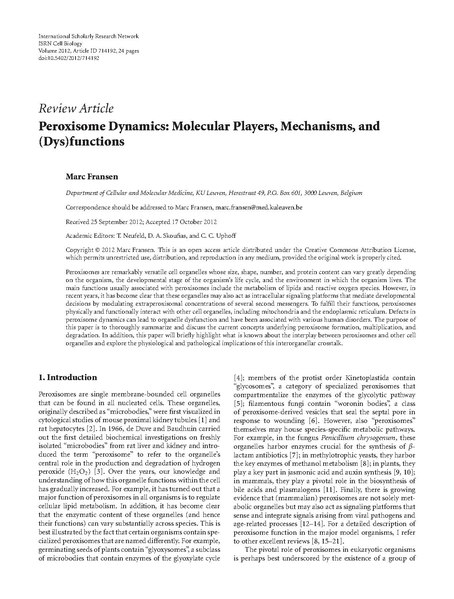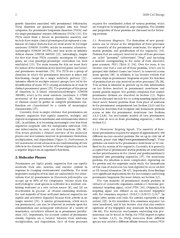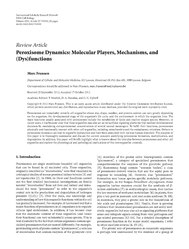File:Peroxisome Dynamics-Molecular Players,Mechanisms, and (Dys)functions.pdf
From Wikimedia Commons, the free media repository
Jump to navigation
Jump to search

Size of this JPG preview of this PDF file: 454 × 599 pixels. Other resolutions: 182 × 240 pixels | 364 × 480 pixels | 582 × 768 pixels | 1,250 × 1,650 pixels.
Original file (1,250 × 1,650 pixels, file size: 375 KB, MIME type: application/pdf, 25 pages)
File information
Structured data
Captions
Captions
Add a one-line explanation of what this file represents
Summary[edit]
| Peroxisome Dynamics:Molecular Players,Mechanisms, and (Dys) functions
( |
||
|---|---|---|
| Author |
Marc Fransen |
|
| Illustrator |
International Scholarly Research Network |
|
| Title |
Peroxisome Dynamics:Molecular Players,Mechanisms, and (Dys) functions |
|
| Volume | 2012 | |
| Publisher |
International Scholarly Research Network |
|
| Description |
English: Peroxisomes are remarkably versatile cell organelles whose size, shape, number, and protein content can vary greatly depending on the organism, the developmental stage of the organism’s life cycle, and the environment in which the organism lives. The main functions usually associated with peroxisomes include the metabolism of lipids and reactive oxygen species. However, in recent years, it has become clear that these organelles may also act as intracellular signaling platforms that mediate developmental decisions by modulating extraperoxisomal concentrations of several second messengers. To fulfill their functions, peroxisomes physically and functionally interact with other cell organelles, including mitochondria and the endoplasmic reticulum. Defects in
peroxisome dynamics can lead to organelle dysfunction and have been associated with various human disorders. The purpose of this paper is to thoroughly summarize and discuss the current concepts underlying peroxisome formation, multiplication, and degradation. In addition, this paper will briefly highlight what is known about the interplay between peroxisomes and other cell organelles and explore the physiological and pathological implications of this interorganellar crosstalk.. |
|
| Language | English | |
| Publication date | 25 September 2012 | |
| Current location |
Department of Cellular and Molecular Medicine |
|
| Accession number |
Article ID 714192 |
|
| Source | https://cyberleninka.org/article/n/55 | |
| Permission (Reusing this file) |
This file is licensed under the Creative Commons Attribution-Share Alike 4.0 International license.
|
|
This file, which was originally posted to
https://cyberleninka.org/article/n/55, was reviewed on 30 October 2021 by reviewer Lymantria, who confirmed that it was available there under the stated license on that date.
|
File history
Click on a date/time to view the file as it appeared at that time.
| Date/Time | Thumbnail | Dimensions | User | Comment | |
|---|---|---|---|---|---|
| current | 13:29, 10 September 2021 |  | 1,250 × 1,650, 25 pages (375 KB) | Contributers2020 (talk | contribs) | {{Book |author = Marc Fransen |illustrator = International Scholarly Research Network |title = Peroxisome Dynamics:Molecular Players,Mechanisms, and (Dys)functions |volume = 2012 |publisher = International Scholarly Research Network |source = https://cyberleninka.org/article/n/55 |accession number = Article ID 714192 |series title = |language = {{language|1=en}} |description = {{en|1=Peroxisomes are remarkably versatile cell organelles whose size, shape, number, and protein content can vary... |
You cannot overwrite this file.
File usage on Commons
The following 2 pages use this file:
Metadata
This file contains additional information such as Exif metadata which may have been added by the digital camera, scanner, or software program used to create or digitize it. If the file has been modified from its original state, some details such as the timestamp may not fully reflect those of the original file. The timestamp is only as accurate as the clock in the camera, and it may be completely wrong.
| Image title |
|
|---|---|
| Author | Marc Fransen |
| File change date and time | 15:28, 10 April 2013 |
| Date and time of digitizing | 15:28, 10 April 2013 |
| Date metadata was last modified | 15:28, 10 April 2013 |
| Software used | LaTeX with hyperref package |
| Conversion program | Acrobat Distiller 7.0 (Windows) |
| Encrypted | no |
| Page size |
|
| Version of PDF format | 1.6 |

